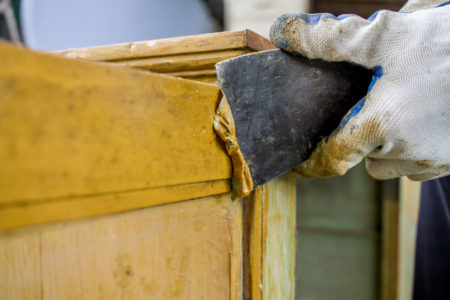
Share On Social!
For the first time in 30 years, the EPA has updated section 6 of the Toxic Substances Control Act (TSCA) — moving to ban toxic chemicals in consumer paint-stripping products.
The rule, released late last week, will prohibit online or retail sales of any paint stripping products containing these chemicals. Latino and environmental groups recently took legal action to spur the EPA toward action. Multiple groups, including Salud America!, informed the public about this issue.
However, the EPA did not make final decisions on methylene chloride use in commercial paint removers. Nor did the agency address the use of alternative substances.
Latinos, who face the most significant levels of chemical exposure through work, remain unprotected by the new ruling, some experts say.
What are the New Rules?
The outcry concerning these chemicals has been a forefront issue for years when reportedly multiple deaths from methylene chloride exposure occurred.
“In this final rule, EPA has determined that the use of methylene chloride in consumer paint and coating removal presents an unreasonable risk of injury to health due to acute human lethality,” the EPA stated in its pre-publication notice.
Section 6 of the TSCA gives the EPA powers to prohibit or constrain the manufacturing and selling of certain chemicals it deems to pose a risk to users.
This specific ruling will ban retailers and manufacturers from importing, producing, and selling products that contain methylene chloride.
Who is Still at Risk?
The largest group still vulnerable to toxic exposure are laborers who work with these chemicals frequently, including Latinos.
“We will not allow this administration to once again attack our community, because that is what this rule does, it leaves workers blatantly exposed to deadly chemicals,” said Hector Sanchez Barba, Labor Council for Latin American Advancement Executive Director, who took part in a recent lawsuit against EPA, in an Earthjustice press release.
“Latino and immigrant workers are overly represented in jobs that require exposure to deadly working conditions, including paint strippers.”
According to the EPA’s 2017 proposed rule concerning methylene chloride, roughly 32,600 workers are estimated to face exposure while on the job.
While they have yet to make a final ruling concerning commercial uses, they are taking public comment concerning worker’s safety.
“While EPA proposed a determination of unreasonable risk from the use of methylene chloride in commercial paint and coating removal, EPA is not finalizing that determination in this rule,” the EPA stated.
Is the Public Satisfied?
While this ruling is a step in the right direction, according to Wendy Hartley, whose son, Kevin, died from exposure despite proper application training, it is not enough.
Many, including Hartley, have spoken out against the lack of protection for laborers.
“I am deeply disappointed that the EPA has decided to weaken its proposed ban on methylene chloride,” Hartley said in a statement. “Getting this deadly chemical out of consumers’ hands is a step in the right direction — a step that was started by retailers nationwide. Workers who use methylene chloride will now be left unprotected and at risk of health issues or death. I will continue my fight until the EPA does its job.”
Editor’s Note: This article is part of a collaboration between Salud America! and the Hoffman Toxicant-Induced Loss of Tolerance (TILT) program at UT Health- San Antonio. To find out if you are TILTed due to exposure to everyday foods, chemicals, or drugs, take a self-assessment or learn more about TILT.
Explore More:
Chemical & Toxic ExposureBy The Numbers
1
Quick Survey
Can help you find out how chemically sensitive you are




